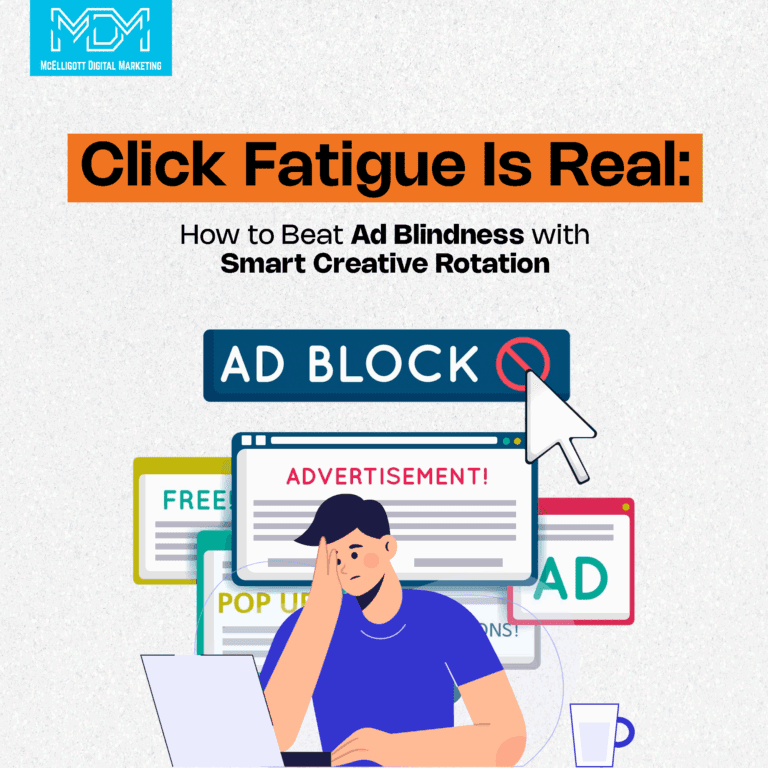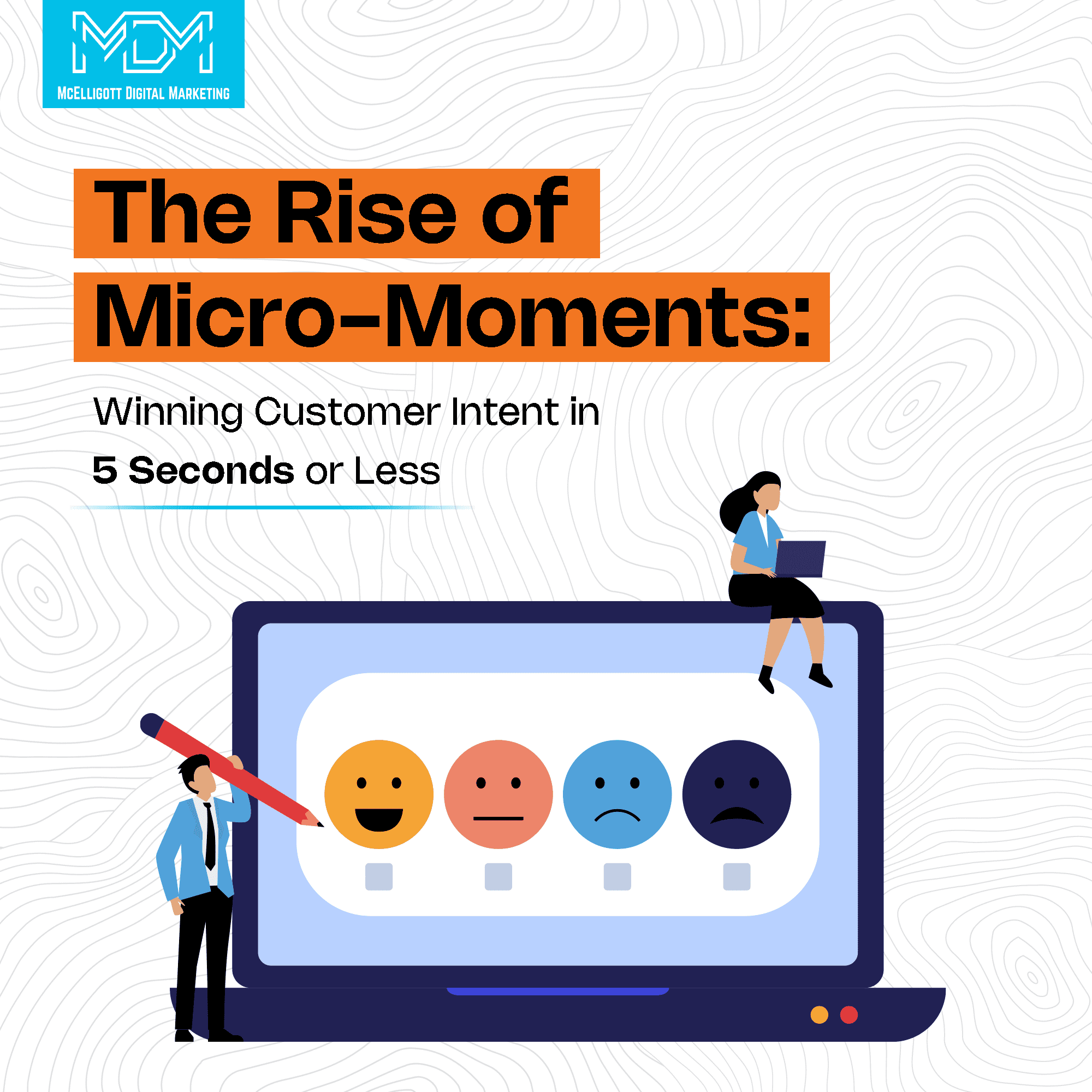If your ads are getting fewer clicks, higher costs, and less attention it’s probably not your targeting. It’s click fatigue.
When people see the same ad over and over, they stop noticing it. Performance drops. Budgets get wasted.
The fix? Creative rotation. Swapping out your visuals, headlines, and formats before your audience gets bored.
In this blog, we’ll break down what click fatigue is, how to spot it, and how to keep your ads fresh, relevant, and effective without starting from scratch every time.
What Is Click Fatigue (and Why It Happens)
Click fatigue happens when your ads run too long, look the same, and stop making people care. It’s not a myth, it’s a performance drop waiting to happen.
Your audience sees the same image, same headline, same message. At first, it works. Then it slows. Then it dies. That’s click fatigue.
Let’s break down why it happens:
- People mentally tune out : After a few exposures, the brain files your ad under “already seen.” No clicks. No conversions. Just scrolls.
- Ad platforms over-optimize : Google and Meta push winning creatives—fast. But when you leave those creatives unchanged, frequency goes up, results go down, and your CPA climbs.
- Mobile makes it worse : Scroll speed is faster. Attention is shorter. If your ad doesn’t pop in a second, it’s skipped. And if it looks familiar? Even easier to ignore.
- Users expect freshness : Your customers are used to new. They binge-watch, swipe, refresh, repeat. A static ad feels lazy. Worse—it feels invisible.
- Repetition without reason kills interest : The same offer, same tone, same visual won’t keep performing forever. And if you’re not rotating? You’re paying more for less.
Click fatigue doesn’t just hurt one ad it drags down your whole account. Lower engagement means higher costs, weaker relevance scores, and less reach.
5 Signs Your Ads Are Fatigued
Ad fatigue doesn’t happen overnight but when it hits, performance can nosedive fast. Audiences get tired of seeing the same creative, and instead of converting, they scroll right past. The key is knowing what to look for before your budget starts bleeding.
Here are five clear signs your ads are past their prime:
1. Click-Through Rates (CTR) Are Dropping
One of the first red flags. If CTR was steady and then starts to dip even with the same audience it’s often a signal that your creative has lost its appeal. People have seen the ad too many times, and it’s no longer grabbing attention.
2. Impressions Stay High, Engagement Slows Down
If platforms keep showing your ad (high impressions), but no one’s clicking, liking, or converting, it could be creative fatigue. High reach with low engagement usually means your audience is tuning out.
3. Cost-Per-Click (CPC) Is Rising
When users stop engaging, platforms respond by raising your CPC. Why? They want to show relevant ads, and if yours isn’t performing, they’ll make you pay more for the same spot.
4. Frequency Score Is Climbing
Frequency tells you how many times the same person has seen your ad. A frequency of 2–3 is okay but once you hit 5+, especially without conversions, it’s time to switch things up.
5. Conversions Plateau or Decline
Maybe your ad was working well until it wasn’t. A sudden dip in conversions (or leads that aren’t converting anymore) often means the audience has seen your message too many times and no longer finds it compelling.
Pro Tip: You don’t need to overhaul your entire campaign. Sometimes, changing just the image, headline, or CTA can reset performance.
Why Creative Rotation Works (The Psychology)
Audiences don’t just get bored, they tune out. That’s the core of click fatigue. And it’s not about bad ads, it’s about repetition without variation.
Psychologically, our brains are wired to ignore what feels familiar. It’s called “ad blindness.” Once someone sees the same image or headline multiple times, their brain files it away as unimportant. That’s why even your best-performing ad can stop working without warning.
Creative rotation works because it reignites attention. By swapping in fresh visuals, new headlines, or slightly tweaked CTAs, you re-trigger curiosity. And that tiny shift? It’s often enough to reset engagement.
Here’s the science in play:
- Habituation: Repeated exposure dulls response. Rotation breaks the pattern.
- Novelty bias: The brain naturally favours newness and attention spikes when something unexpected appears.
- Micro-interruptions: Changing creatives disrupts scrolling just long enough to recapture interest.
The key isn’t to overhaul your messaging constantly but to create variations with intention. Think of it like remixing a hit song same vibe, different hook.
Whether you’re targeting cold leads or retargeting past visitors, strategic creative swaps keep your brand feeling alive, not overplayed.
Because in a feed full of sameness, freshness wins attention.
Mobile-First Behavior Amplifies Fatigue
We live on our phones. And while that means more ad impressions, it also means more opportunities for burnout.
Today, more than 70% of digital ad traffic comes from mobile. Users are scrolling fast, multitasking harder, and paying less attention with every swipe. That’s the perfect storm for click fatigue.
On mobile, screen space is limited, and so is patience. If your ad looks the same every time same colors, layout, and messaging it blends in. People don’t even register it anymore. They scroll right past it like it was never there.
Worse, mobile behavior is repetitive. People open the same 3–5 apps multiple times a day. If your ad shows up in the same format with the same look during every scroll session, it’s game over for engagement.
Here’s what amplifies fatigue on mobile:
- Tight spaces mean visuals get less time to impress.
- Fast scrolling reduces your window to capture attention.
- Algorithmic repetition often shows the same ad too many times to the same person.
To combat this, brands need to design with scroll-stopping variety. That means mixing up creatives, using vertical-first formats, rotating ad copy, and keeping your visuals fresh and thumb-friendly.
Remember: mobile users don’t give second chances. You either catch their eye or disappear into the scroll.
So if your ads are starting to feel stale, check how they look and feel on mobile first. That’s where the fatigue starts and where your fix should begin.
Urgency & Attention-Grabbing Copy That Cuts Through
Digital attention spans are shrinking fast and so is your window to make an impact. That’s where urgency and punchy copy come in.
When a user sees “Only 3 left” or “Offer ends tonight,” something happens: their brain flags it as important. Urgency taps into a basic human instinct: the fear of missing out (FOMO). This emotional trigger can drive faster decisions and higher engagement.
But urgency only works when it feels real. Fake countdown timers or overused phrases like “limited time only” can backfire if they’re not backed by truth. Credibility matters. Your copy should be sharp, but also grounded in something you can deliver.
Need to break through the scroll? Here’s what works:
- Action-first headlines: “Book Now,” “Don’t Miss This,” “Grab Yours Today.”
- Specific timeframes: “Ends in 6 hours” outperforms “limited time.”
- Clear outcomes: “Save ₹1,000 today” feels more tangible than “Great deal.”
On mobile, where users skim even faster, clarity and urgency become non-negotiable. The right words short, bold, benefit-driven can mean the difference between a scroll-by and a click.
Creative Rotation Strategy: What to Change and How Often
When your audience starts ignoring your ads, it’s usually not the platform, it’s the creative.
Running the same visuals, copy, and layout for weeks (or months) is a fast track to click fatigue. Even your best-performing ad will lose steam if it’s overexposed. That’s where creative rotation comes in: refreshing your ads before performance drops.
So, what should you change?
Here’s a quick breakdown:
- Visuals: Change imagery, video thumbnails, or background colors. Even minor tweaks like text placement can improve scroll-stopping power.
- Ad Copy: Switch up your hook, CTA, or headline. Test different emotional triggers urgency, curiosity, or value-based messaging.
- Format: Alternate between static images, carousels, short-form videos, and GIFs. Platforms reward creative diversity.
- Audience Segments: A new creative might work better for a specific age group, region, or interest test accordingly.
How often should you rotate?
- For high-frequency campaigns (daily spend ₹1,000+): every 10–14 days
- For moderate campaigns: rotate creatives every 3–4 weeks
- If CTR drops by 30%+ or CPM starts rising: it’s time for a refresh
Pro tip: Don’t just swap things randomly. Use A/B tests to track what’s working—and why. Over time, you’ll build a data-backed content bank that keeps your ads fresh without starting from scratch every time.
Tools & Platforms to Automate Smart Rotation
Rotating creatives manually across campaigns and platforms? That’s not scalable and definitely not efficient. The good news is: there are tools built for this exact problem.
If you want to beat ad fatigue at scale, automation is your best friend. Here are some reliable tools and platforms that make smart creative rotation simple:
1. Meta Advantage+ Creative
Meta’s built-in creative optimization tool automatically tests variations of your ad copy, visuals, CTAs and delivers the highest-performing combinations to each user.
Why it works:
- Uses AI to personalize creatives for different audience segments
- Reduces the need for constant manual updates
2. Hunch
Built specifically for dynamic creative scaling. Hunch helps brands create, test, and rotate thousands of ad variations across platforms especially for ecommerce.
Top features:
- Dynamic product ads
- Feed-based creative automation
- Real-time fatigue detection
3. Canva + Zapier
For small teams, automating visuals can start with a Canva template + Zapier workflow. You can generate variations and schedule them for publishing all without writing code.
Best for:
- Lightweight automation
- Fast refreshes with branded templates
4. Google Ads Responsive Display Ads
Google automatically tests different combinations of headlines, images, and descriptions and adjusts based on what works best for your audience.
Why use it:
- Performance-based rotation
- Supports multiple formats (text, image, video)
Bonus Tip: No matter what tool you use, set alerts for rising CPM or falling CTR these are your early warning signs that a creative swap is due.
Ad Fatigue Prevention Plan (Checklist)
Want to stop ad fatigue before it starts? Don’t wait for your metrics to drop. Build a proactive system that keeps your creatives fresh, relevant, and high-performing.
Here’s your go-to Ad Fatigue Prevention Checklist:
Set Rotation Reminders
Change your creatives every 7–10 days for fast-moving campaigns, and every 2–3 weeks for evergreen ads. Add it to your calendar so it doesn’t slip through the cracks.
Track Performance Drop-Offs
Watch for sudden dips in:
- CTR (Click-Through Rate)
- ROAS (Return on Ad Spend)
- Engagement (likes, comments, shares)
If it slides for more than 2–3 days, it’s time for a swap.
Refresh, Don’t Reinvent
Rotate headlines, visuals, and CTAs but keep the core message if it’s working. You don’t need a brand-new idea every time, just a fresh coat of paint.
Have Variations Ready
Batch-produce 3–5 creative versions per campaign. Think ahead so you’re not scrambling when fatigue hits.
Use Platform Tools
Leverage Meta’s Advantage+ or Google’s Responsive Ads to let AI do the heavy lifting on real-time testing and rotation.
Build a Swipe File
Save high-performing ad ideas, hooks, and visuals. Refer back when you’re stuck or short on time.
Conclusion
To beat ad fatigue, you need more than just new creatives, you need a smarter system.
It’s not about replacing ads for the sake of it. It’s about rotating with purpose, timing your updates, and aligning your message with what your audience actually wants to see. When done right, creative rotation doesn’t just maintain performance it improves it.
Fresh ads grab attention. Strategic rotation keeps results steady. And the right tools make it scalable.
Whether you’re optimizing one campaign or managing dozens, staying ahead of fatigue is how you stay competitive.
Need help building a rotation strategy that clicks?
Let’s refresh your creative game before fatigue sets in.
FAQs
1. How often should I rotate my ad creatives to avoid fatigue?
For high-budget campaigns (₹1,000+ per day), rotate every 10–14 days. For moderate campaigns, switch creatives every 3–4 weeks. If you notice a drop in CTR or a spike in CPC, refresh sooner.
2. What parts of my ad should I change during rotation?
Start with visuals (images, videos), headlines, CTAs, and layout. Even small tweaks—like changing background color or text placement can reset performance without scrapping the whole concept.
3. Can automation tools really help with creative fatigue?
Yes. Tools like Meta Advantage+, Google Responsive Ads, or Hunch help test and rotate creatives at scale, using performance data to optimize delivery. They save time and keep your ads feeling fresh.
4. What’s the difference between ad fatigue and a bad campaign?
A bad campaign struggles from day one. Fatigue happens when a previously high-performing ad starts losing impact due to repetition. If performance drops after success, it’s likely fatigue not failure.





